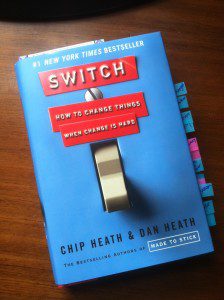I’ve been reading Switch; how to change things, when change is hard by Chip Heath & Dan Heath. You can see I already have lots of tabs to make it easy for me to find the points that mean the most to me.
 Plus I’m lucky enough to have Babette Ten Haken and Nancy Nardin to chat with about what we each think. Come back because both Babette and Nancy will have their own posts about the topic and I’ll link back to them for you.
Plus I’m lucky enough to have Babette Ten Haken and Nancy Nardin to chat with about what we each think. Come back because both Babette and Nancy will have their own posts about the topic and I’ll link back to them for you.
The book is broken down into three sections: Direct The Rider, Motivate The Elephant, and Shape The Path. This month we talked about the first section – Direct The Rider to give you a little context Switch uses an elephant analogy with the rider being your rational side and the elephant being your emotional side.
I’m not going to go into the book – you can do that yourself. What I am going to do is give you my three favorite highlights:
big problem, small solution
“Big problems are rarely solved with commensurately big solutions.” (pg 44)
There are some great stories and examples in the book about this idea. I’ll give you my real world inside sales story instead.
As a new to the career salesperson I found that I’d get off a call and know about the topic we started with BUT not about anything else that was going on in the prospect’s world. What I was told was “Lynn you’ve got to dig deeper.” Which addressed the big problem, but I had no idea what to do about it.
Who said it has been lost to time but somehow I began to ask at the end of every single call “is there anything else I can do for you today?”
The answers were astounding:
* day to day supplies they needed, when we’d been talking about a project
* vica versa – a project that wasn’t starting that day but was coming up soon
* things that they needed help with that I couldn’t help with
* things they DIDN’T think I could help with, but I could
* and sometimes there was nothing
It even became a joke, and I’d say “well if you think of something in the next 7 minutes, don’t be embarrassed – just call me back” AND I would get calls back the same day from my customers who had thought of something for me to help them with.
big problem; “Lynn you’ve got to dig deeper.”
small solution; asking “Is there anything else I can do for you today?”
ambiguity is the enemy
What is required is “needed direction, not motivation.” (part of a story on pg 28)
If you’ve hired the right salespeople (and I’ll assume you have) they are already motivated to achieve their definition of success. As their leader, you need to give them direction of what needs to be done.
Also remember that small solution tip – make sure you’re focusing in on one thing with each rep instead of trying to solve the big problem all at once.
clarity dissolves resistance
“if you want people to change, you must provide crystal-clear direction.” (pg 16)
Often I’ve heard sales managers and leaders give direction that is less than crystal-clear. Need an example? How about telling a sale team to “sell more” or instruct them to “call more people”
I know I’ve been guilty of that in training as well! Which leads us to…
What impact does this have on inside sales training?
I’m so glad you asked! My training programs are already changing a bit. I have been giving people the ideas they need, the flexibility to make it their own, but never really making sure when they leave it is in a form that they use immediately to implement the new ideas into their sales day.
I’ll admit, I assumed that if I pointed them in the right direction – they would do that piece for themselves.
Will the content completely change? Of course not – but now there will be a tangible, plan for the participants to implement when they get back to their desks.
I’m not telling them what to do, we will still create their plan together; rather I’m making sure they are pointed in the right direction AND it is simple and crystal-clear on what they are going to do – starting immediately.
What can you do today?
* to help your team with small solution to a big problem
* defeat the the enemy of ambiguity
* and dissolve resistance with clarity

This Post Has One Comment
[…] colleagues Nancy Nardin and Lynn Hidy and I are discussing Chip Heath and Dan Heath’s book, Switch, How to Change Things When Change is […]